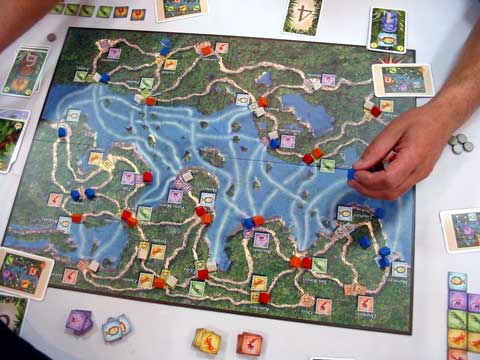“Bright” and “colourful” are the two words that immediately spring to mind on seeing Amazonas. This starts with the parrot on the box and continues with the pieces inside. The game comes in the square box that Kosmos use for their bigger games. Inside we find a good-looking board and colourful, chunky cardboard pieces for the five types of specimen players collect. There are brightly coloured wooden pieces representing tents, wooden gold and silver pieces, a substantial deck of cards and a few other markers. All very nicely produced. The board shows a stretch of the Amazon river and the forest on either side. The key features are the villages and the routes between them: through the forest or across the river. Each village shows a type of flora and fauna that can be found there – these specimens are worth points and collecting them is the main aim of the game. Holding fewer than three specimens of a type is worth nothing, so there’s a big incentive to concentrate on just a few types of specimen. However, getting a specimen of each type earns an immediate bonus – 5 points for the first person, 4 for the next and so on. Here’s an incentive to collect all the types – and quickly. My approach is to go for one of everything first to get the bonus and then see which specimens it makes sense to focus on. 
Everybody starts with the tent pieces and Bid cards in their colour. The sets of Bid cards contain the same values, but also have tie-breakers, so they’re not quite identical. A random Mission card is also dished out. Each Mission shows a set of villages. At the end of the game, players lose points for each of the villages shown on their Mission card that they don’t have a tent in. And losing points for just one village can make a difference. My approach is to incorporate my key villages into my initial collection of specimens. Which takes priority will depend on the circumstances. Having studied their Mission, each player places (and pays for) one tent as their base camp. This is important, too, as further tents can only go into villages that are connected to somewhere they already have a tent. Through the game networks of tents are created across the board. It’s worth studying the routes across the board and planning connections. As you can see, starting the game needs a bit of thought. To begin each turn, an Event card is turned over. These are a mixture of bonuses (extra income depending on a type of specimen) and hazards (blocking forest or river paths, reducing income and so on). Then players choose a Bid card: when all have chosen, the cards are revealed. Revealed cards stay on the table, so options get more limited each turn. But, once the whole set has been used, the cards are picked up again. First, the Bid cards determine the order of play. Then, in turn order, players get their income and spend money placing a tent. Income comes in silver pieces, according to the value of the Bid card played plus any bonus. Villages have spaces for two or three tents which cost 2-5 gold (three silver make one gold and can be changed at any time). An important tactic in the game is getting the cheaper spaces in the villages. Given the gap between income and cost, there are often turns when a tent can’t be placed. The game ends when there are no more Event cards. The scores are totted up, any penalties for failing to complete a Mission card deducted and whoever has the most points wins. What we have here is a game with a bit of complexity in its rules, that requires some planning and has plenty of luck (or random elements, anyway). The complexity of the rules and the strategic elements put it above the usual family game (not unusual for a German publisher). The luck factor and the simplicity of play mean it isn’t particularly challenging for gamers. It is a pleasant game that offers a bit of challenge, is fun to play and finishes nicely in an hour. Amazonas was designed by Stefan Dorra and is published by
Kosmos (in Germany) and Mayfair Games (USA). It is a board game for 3-4 players
and takes about 50 minutes to play. It is readily available in UK shops. |
Pevans |